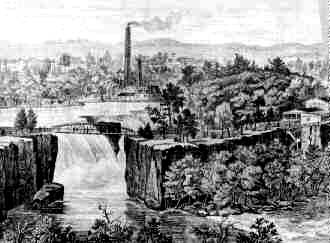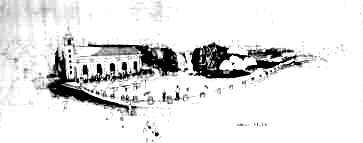
Print of the Great Falls. c. 1865. shows iron arched-truss "Old Falls Bridge'' (c. 1850), a water pumping station at center rear and a former resort inn. (Reid Collection)
Preservation News, National Trust for Historic Preservation, May, 1971

Print of the Great Falls. c. 1865. shows iron arched-truss
"Old Falls Bridge'' (c. 1850), a water pumping station at center rear and
a former resort inn. (Reid
Collection)
Attention was first centered on the area when citizens applied to have the
Falls designated a National Natural Landmark. The designation was approved
in 1967. Interest in cleaning up the polluted Passaic River and developing
an open space area around the Great Falls has continued.
On the advice of experts, supporters of the project included in their plans preservation of the surrounding industrial district, which developed after the Society for Establishing Useful Manufactures (SUM) located in Paterson in 1792. The Society was the first American experiment in large scale manufacturing on a single site. In use ever since, the area illustrates the growth and changes in industrial planning, engineering and architecture that occurred from 1793 to 1912.
Significant structures include the Rogers Locomotive Works and the remains
of Samuel Colt's armory (1835), where the Colt revolver was first manufactured.
In addition to 60 other structures, the district includes three millraces,
one engineered by Pierre Charles L'Enfant; two dams and several historic
bridges. In April 1970, the Great Falls/ SUM Historic District was added
to the National Register.
The Great Falls Project Committee, led by Mrs. Mary Ellen Kramer, wife of
Paterson's mayor, has been assisted in developing a plan for the area by
Urban Deadline Architects of New York City. The group maintains that preservation
of the historic industrial district is of vital importance to the city's
entire business area.

Drawing of proposed development of the Falls area. The building
at left is the SUM electric generating plant (1912-14), built to provide
a power source for the SUM industries. (Urban
Deadline Architects)
This area, they say. is also the key to understanding an important characteristic
of Paterson. Traditionally industrial, Paterson continues to be chiefly a
place to work. But the stereotype of a grimy, blighted milltown has dimmed
the city's earlier reputation for growth and pragmatism. The committee hopes
to renew civic pride and reaffirm the old image of the city by halting the
spread of blight within the historic district and again making the area a
viable economic resource.
Consultants from the Historic American Buildings Survey. the National Trust
and the Smithsonian Institution have confirmed the historical and architectural
value of the area and given their support to the project.
The situation is complicated by the imminent construction of Route 20. Straddling
the project area, the highway would take a number of the historic structures
and cut off the remaining portions of the area from the city.
The project committee, the mayor of Paterson and other city agencies have
been negotiating with the design department of the state Department of
Transportation to modify the proposed design of the highway. The state is
unwilling to do this unless the city agrees to bear all increased costs
occasioned by the delay. Although alternative designs have been considered,
none changes radically the main alignment of the highway through the core
of the historic area.
Since federal highway funds are involved, the project is being studied informally
by the office of the National Register to avoid review by the Advisory Council
on Historic Preservation. Such action is required under Section 106 of the
Historic Preservation Act of 1966.